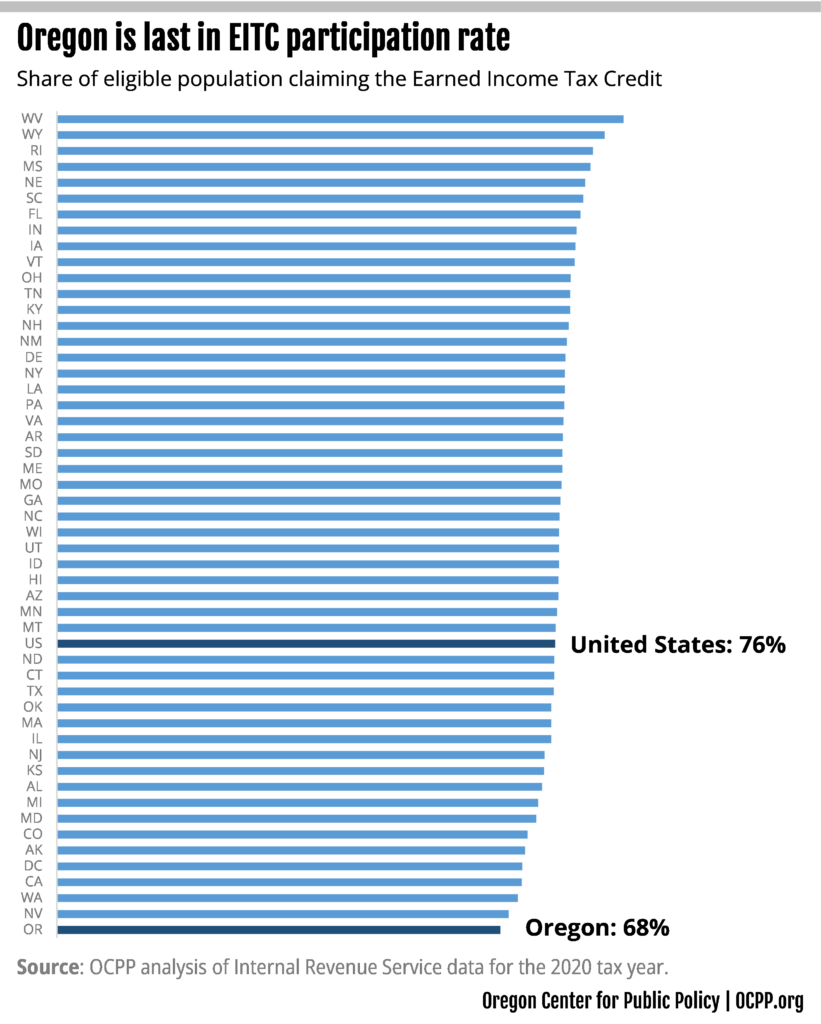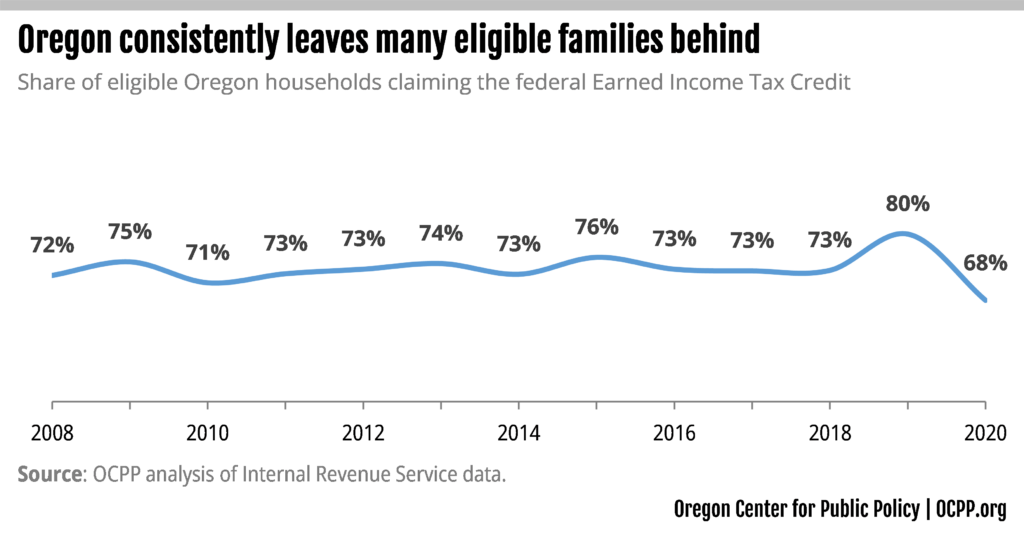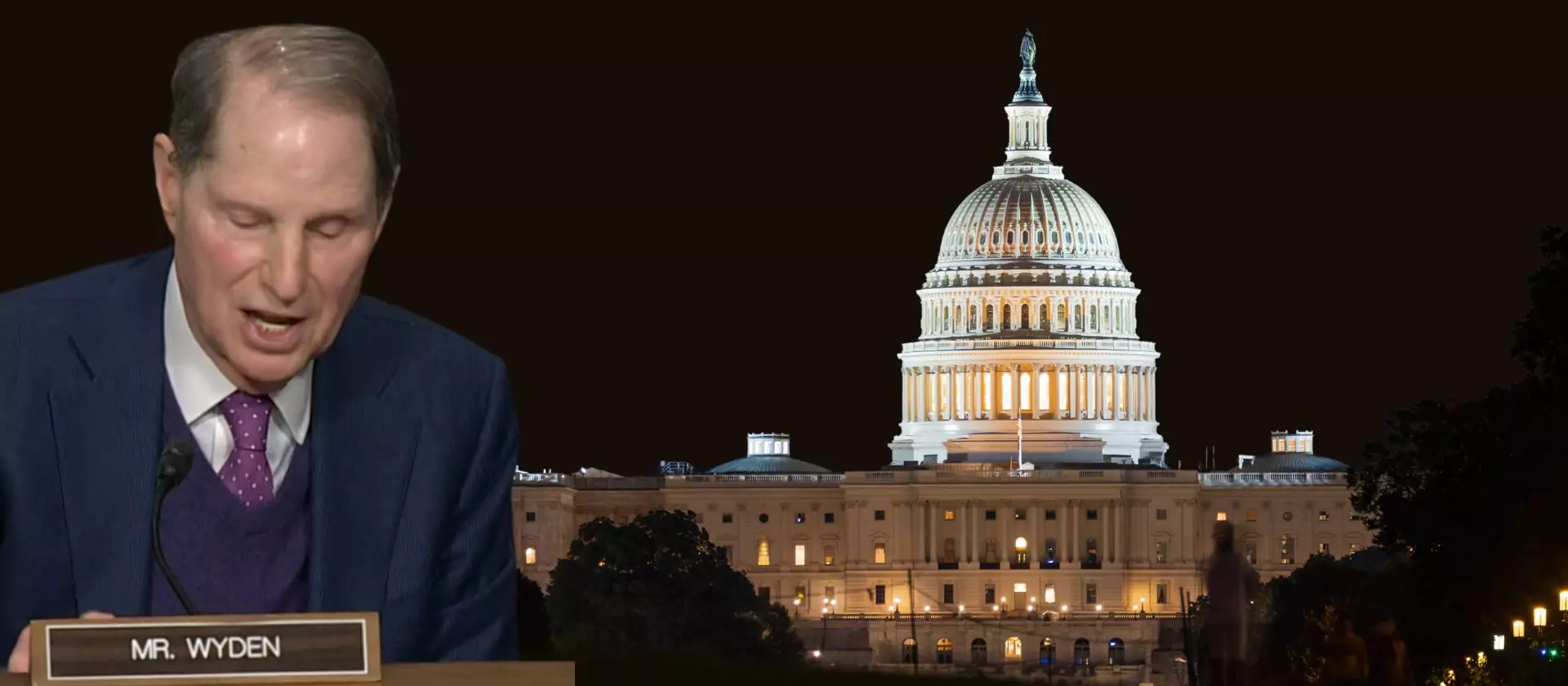Oregon families are among the least likely to benefit from the Earned Income Tax Credit (EITC) — a tax credit designed for families surviving on low wages. In 2020, Oregon had the worst EITC participation rate in the nation. That year, nearly one in three eligible Oregon households did not claim the credit.
Families and the state both pay the price when eligible households do not claim the EITC. The EITC helps low-income family makes ends meet and improves the well-being of children, but these benefits only materialize when families claim the credit. In 2020, Oregon households collectively missed out on $96 million in federal dollars — money that otherwise would have flowed to Oregon communities.
The main barrier that eligible households face in claiming the credit is the complexity involved in filing taxes. That is why federal and state action to make tax filing simple and free are key to increasing participation in the EITC.
Oregon consistently has one of the nation’s lowest EITC participation rates
In 2020, the year with the most recent data on federal EITC participation, about 257,000 Oregon families claimed the tax credit.[1] This accounted for an estimated 67.9 percent of all Oregon working families that were eligible that year. Oregon’s participation rate in 2020 was the worst in the country, with 49 states plus the District of Columbia faring better.

About 93,000 Oregon working families who were eligible for the federal EITC in 2020 did not access it. Together, these families missed out on about $96 million federal dollars that year.[2]
Oregon’s poor performance in 2020 is consistent with its long-term pattern. Oregon’s EITC participation rate has fluctuated over the prior decade peaking at 79.6 percent in the 2019 tax year. Oregon’s rate of 67.9 percent in 2020 was the lowest on record.[3] Having the record low and record high in back-to-back tax years should be taken with a grain of salt, as the COVID pandemic likely affected the accuracy and consistency of data collection.[4] In fact, the average of the 2019 peak and 2020 trough (73.8 percent) is almost identical to the prior decade average (73.3 percent). Outside of the 2019 spike, Oregon has consistently been at or near the bottom of the state rankings.

Low EITC participation harms families and the state
When the EITC goes unused, families lose out on the benefits of a policy proven to improve well-being. At the same time, the state fails to capture substantial federal dollars that would otherwise circulate in the state’s economy.
The EITC is one of the most effective tools for helping working families meet their basic needs and improve their lives. In 2020, the average federal credit for Oregon households that claimed it was nearly $2,000. Of those that included children, the average was even higher — nearly $3,000.[5] The amounts provided by this refundable tax credit typically help families catch up on bills, purchase or repair a car, or invest in activities that enrich their children’s lives.[6] The broad benefits of the EITC are well documented. The federal EITC helps lift about 68,000 Oregonians, including 34,000 children, out of poverty.[7] Layering on the roughly $60 million per year in state EITC dollars further amplifies the anti-poverty impact of the EITC in Oregon.[8]
For children, the EITC has a lasting impact. A substantial body of research shows that tax credits such as the EITC improve child health, boost school performance, promote college enrollment, and increase earnings when children become adults.[9]
All of these benefits fail to materialize for eligible families that do not claim the credit. Research indicates that about half of all the poorest families eligible for the EITC do not claim it.[10] This means that the credit fails to reach a large portion of the families most in need.
Oregon’s low EITC participation not only undermines the well-being of families, it also represents a loss to the state. The EITC adds dollars to the Oregon economy by giving working people more money to spend. In 2020, the federal EITC brought more than $500 million in federal dollars to Oregon, dollars that flowed to every corner of the state.[11] Nevertheless, Oregon left $96 million in federal dollars on the table, due to the fact that families eligible for the EITC did not claim the credit.
The economic loss to Oregon is even greater than that. Eligible families tend to spend their EITC refunds quickly at local businesses, as they make purchases to meet their basic needs. This spending generates more economic activity. Researchers estimate that each federal EITC dollar results in $1.40 to $1.58 in activity in the economy, as local businesses use EITC dollars to purchase goods and services and pay employees, and employees spend their earnings.[12] This leaves the impact of unclaimed federal EITC at $135 million to $152 million each year in economic activity in Oregon.
Raising awareness alone cannot overcome the problem
Although Oregon has taken laudable steps to increase EITC participation by raising awareness of the credit, those efforts have done little to move the needle. In 2017, in response to Oregon’s persistently low EITC participation rate, the Oregon legislature enacted a bill to increase awareness of the tax credit.[13] The law requires employers to provide all workers written notice at tax time of the federal and state EITCs. It also directs the Bureau of Labor and Industries and the Oregon Employment Department to take certain steps to inform workers about the credit. Oregon’s continued low participation rate in the EITC, however, indicates that Oregon’s outreach campaign has had limited impact.
Oregon’s experience is consistent with research findings. For instance, a study in California conducted an outreach campaign to over one million Californians to assess its impact on EITC participation.[14] The study tested six approaches using different formats, text, and messengers. Most of the experiments employed multiple languages. None of the informational campaigns, however, had any impact on EITC participation, leading the researchers to conclude that outreach “alone is insufficient to improve take-up of the EITC.”[15]
The ineffectiveness of awareness campaigns as a standalone strategy points to structural reforms as a necessary ingredient.
The complexity of filing taxes is the main barrier
The complexity involved in filing taxes is the main barrier to eligible households claiming the EITC. That complexity leads people to not want to deal with the hassles of filing taxes, creates confusion as to eligibility for the credit, imposes transaction costs, and creates fear of errors in claiming the credit and potential penalties resulting from those errors.
“The EITC is one of the most complex elements of the tax code that individual taxpayers face,” researchers point out. “The IRS instructions for the credit are nearly three times as long as the 15 pages of instructions for the Alternative Minimum Tax, which is widely viewed as difficult.”[16]
This complexity deters many from filing a tax return, a prerequisite for claiming the EITC. Among those who are eligible for the credit in Oregon but do not receive it, an estimated 98 percent do not file a return, while the remaining 2 percent do file but do not claim the EITC they are eligible for.[17] Researchers who interviewed people who did not file a tax return despite being eligible for the tax credit noted, “Low-income people perceive filing taxes to be challenging and daunting. This is not a new finding . . . but it is worth reiterating how widespread and pervasive the sentiment is.”[18]
Complexity generates confusion. Many of those eligible for the tax credit who do not file a tax return are also not required to file a tax return due to their low incomes, but not filing means missing out on the benefits of the EITC and other refundable tax credits. To some extent, the failure to file a tax return is the result of people believing that only those required to file are allowed to file.[19] At the same time, among those who do not claim the credit despite being eligible are thousands who do file a tax return. That fact itself reveals confusion about program eligibility.
Related to the problem of confusion is the fear that an error in claiming the credit will lead to negative repercussions. Based on interviews of non-filers eligible for the credit, researchers point out that “the complicated cost-benefit analysis that filers go through to determine whether it is worthwhile to file creates fear and feelings of disempowerment.”[20] Stated differently, “They are very afraid of making mistakes in filing.”[21] That fear is justified, given that for years the IRS has been auditing tax filers claiming the EITC at a higher rate than other filers.[22]
Although using an online tax preparation service can reduce some of the burden involved with filing taxes, doing so comes with its own set of challenges and costs. Intuit, maker of TurboTax, the most widely used tax filing software, claims to offer free tax filing for some of its users.[23] That includes EITC filers, but only in the case of tax returns with “no added tax complexity,” like having self-employed income.[24] It’s offers of free filing notwithstanding, Intuit has been found to have steered customers lured by offers of free tax filing into paid services.[25]
Because EITC filers have low incomes, they often don’t have the money to pay for tax preparation services, leaving them vulnerable to exploitation. A good example if this is the Rapid Anticipation Check (RAC) used by the tax preparation industry.[26] A RAC allows filers to defer paying for the tax filing services until they receive their tax refund, effectively serving as a high-interest, short-term loan. RACs drain hundreds of millions of dollars from EITC recipients each tax year.[27]
Volunteer Income Tax Assistance (VITA) programs offer tax filers free tax assistance, but the reach of such programs is limited by inadequate funding and a shortage of volunteers. In 2020, VITA and another tax volunteer program together helped about 18,500 people file taxes in Oregon, which amounts to 1.3 percent of filers likely eligible for such assistance.[28] Filers in rural parts of Oregon face even greater challenges finding access to tax support programs, with only one VITA clinic on the Oregon coast (in Coos Bay), and none east of the I-5 corridor.[29]
Increasing EITC participation requires making tax filing simple and free
Because the complexity of tax filing is the main barrier to claiming the EITC, the solution to the problem of eligible families not claiming the credit rests on making tax filing simple and free. Doing so requires action at both the federal and state level, including:
Creating an integrated Direct File program. Both the IRS and the Oregon Department of Revenue (DOR) have launched pilot programs allowing tax filers to file their taxes directly, at no cost, with the agency. The federal program currently is not available in Oregon, but it could be available in the 2024 tax year. The next step is to link the federal Direct File pilot with Direct File Oregon. With state and federal integration, a taxpayer would only need to enter the vast majority of their data once when filling out the federal return. That information would be automatically loaded into the state return, as is common with paid tax preparation software. This would make tax filing easier, more efficient, and reduce the risk of errors.
Offering pre-filled tax forms. For many tax filers, especially low-income filers, the IRS and DOR already have in their possession all of the information needed to complete a tax return. With an integrated Direct File system in place, the agencies could provide tax filers with pre-filled, draft tax returns that filers could then choose to accept, amend, or reject and start from scratch.[30] For EITC eligible households, pre-filled tax returns would start with the EITC included. In doing so, pre-filled tax returns would remove practically all of the work involved in filing taxes and claiming the credit, as well as reduce the worry of committing errors in filing.
Creating a super-simplified form for non-filers. Taken one step further, the IRS and DOR could create an extremely simplified form for those who are not required to file taxes because their incomes are so low, providing an easy way for them to claim the tax credits for which they are eligible. During the COVID pandemic, the IRS created a non-filer tool for the economic stimulus payments that got millions of checks out to people.[31] Another innovative tool, known as GetCTC, provided an easy option for people to claim their expanded Child Tax Credits. Reports indicate about 200,000 households claimed an estimated $685 million using GetCTC – many of which would likely have not claimed the credit without the simple tool.[32] Using the emerging Direct File services to provide an easy non-filer tool is a crucial way to expand access to refundable tax credits.[33]
Conducting targeted outreach. While outreach by itself has not proven very effective at increasing participation in the EITC, targeted outreach could prove more effective, especially in combination with reduced barriers to tax filing. Targeted outreach is what Illinois did when it sent letters to people who claimed the federal EITC but not the state one, resulting in thousands of residents claiming about $6 million per year in additional credits.[34] Another promising opportunity is for state agencies, such as the Oregon Department of Human Services and the Oregon Employment Department, to share data with each other and DOR with the goal of identifying and notifying EITC-eligible households of the potential to receive thousands of dollars in tax refunds.
Limiting penalties for accidental errors. Given that worries about filing errors and their potential consequences are a barrier to claiming the EITC, limiting the penalties for errors would be beneficial. Both the federal and state government should exempt filers from penalties, late fees, and interest in the case of minor or accidental errors. In cases where the error leads to a tax refund larger than warranted, tax filers should be offered a reasonable repayment period.
Investing in tax assistance. Even with pre-filled tax forms, some tax filers — including filers eligible for the EITC — will need assistance completing their forms. That is because their tax returns may be complicated, or because the filer faces language barriers, or other reasons. Investments in free, culturally-appropriate tax preparation services that are accessible across the state are essential to ensuring all EITC-eligible households receive the credit. Sustained public investment is vital to having a stable network of tax preparation services accessible to those who need assistance throughout the state. Oregon took a key step in recent years by funding the Oregon Department of Human Services Tax Infrastructure Grant program.[35] However, the need far outpaces the funding.
Conclusion
Oregon’s pattern of low EITC participation continued in 2020, when it ranked lowest in the nation. The low participation rate deprives many households surviving on low wages the benefits an EITC refund can bring, while denying the state the influx of federal dollars.
The main barrier households face in claiming the EITC is the complexity involved in filing taxes. That is why increasing the use of the EITC requires federal and state action to create a simple and free tax filing system.
Endnotes
[1] For this fact sheet, unless otherwise noted, all figures are OCPP analysis of Internal Revenue Service (IRS) data. The most recent data on state EITC participation is available here.
[2] Analysis by the Oregon Center for Public Policy based on a calculator provided by the Center on Budget and Policy Priorities (CBPP). The analysis is based on information from the IRS National Taxpayer Advocate and IRS EITC data. It considers that eligible people who don’t claim the credit are more likely to have no children claimed on their return and eligible for a smaller than typical credit. The analysis is based on unpublished IRS estimates of EITC claims by filing status, qualifying children, and average credit amount. Estimates for EITC eligibility in Oregon used a weighted average of Oregon’s participation rates for the last three years – 50 percent for 2020 data, 30 percent for 2019 data, and 20 percent for 2018 data.
[3] Oregon’s EITC participation rate in 2008 was 72.3 percent. Data obtained by OCPP from the IRS in 2019.
[4] Due to higher nonresponse bias during the COVID-19 pandemic, the 2020 ACS estimates use experimental weighting. Caution should be exercised when interpreting these results, especially when comparing to other years. More information is available here.
[5] Analysis by the Center on Budget and Policy Priorities (CBPP) made available to OCPP.
[6] Ruby Mendenhall et al., The Role of Earned Income Tax Credit in the Budgets of Low-Income Families, Social Service Review, February 2012.
[7] Center on Budget and Public Policy analysis of CPS public use files from the U.S. Census Bureau, with corrections to underreporting of benefits from TRIM (Urban Institute/HHS).
[8] 2023-2025 Tax Expenditure Report, Oregon Department of Revenue.
[9] Chuck Marr, et al., The EITC and Child Tax Credit Promote Work, Reduce Poverty, and Support Children’s Development, Research Finds, Center on Budget and Policy Priorities, October 1, 2015.
[10] Nathan Anderson, et al., Why Are Millions of Dollars in Tax Refunds Going Unclaimed?, Federal Reserve Bank of Chicago, ProfitWise News and Views, No. 1, March 2022; and Austin Nichols and Jesse Rothstein, The Earned Income Tax Credit (EITC), National Bureau of Economic Research, May 2015.
[11] OCPP analysis of Internal Revenue Service (IRS) Statistics of Income data for the 2020 tax year.
[12] Antonio Avalos and Sean Alley, “The Economic Impact of the Earned Income Tax Credit (EITC) in California,” The California Journal of Politics & Policy, 2010, Vol. 2, Issue 1; and Targeted Messages Why me? EITC and Other Refundable Credits, Internal Revenue Service.
[13] Senate Bill 398, Oregon State Legislature 2017 session.
[14] Elizabeth Linos et al., Increasing Take-Up of the Earned Income Tax Credit, California Policy Lab, January 2020.
[15] Ibid.
[16] Robert Greenstein, Josh Wancheck and Chuck Marr, Reducing Overpayments in the Earned Income Tax Credit, Center on Budget and Policy Priorities, January 31, 2019.
[17] Research by the Oregon Department of Revenue shared with Governor Kate Brown’s EITC workgroup.
[18] Gabriel Zucker and Lindsey Wagner, Talking to Non-Filers: Evidence from Qualitative Research with Families Who Don’t Regularly File Taxes, New America, July 16, 2021.
[19] Gabriel Zucker and Lindsey Wagner, Talking to Non-Filers: Evidence from Qualitative Research with Families Who Don’t Regularly File Taxes, New America, July 16, 2021; Earned Income Tax Credit: Research Findings in California and Colorado, Code for America, User Research Findings January – July 2019.
[20] Earned Income Tax Credit: Research Findings in California and Colorado, Code for America, User Research Findings January – July 2019.
[21] Gabriel Zucker and Lindsey Wagner, Talking to Non-Filers: Evidence from Qualitative Research with Families Who Don’t Regularly File Taxes, New America, July 16, 2021.
[22] Audits of EITC Returns: By the Numbers, Congressional Research Service, June 13, 2022.
[24] Ibid.
[25] FTC Issues Opinion Finding that TurboTax Maker Intuit Inc. Engaged in Deceptive Practices, Federal Trade Commission, January 22, 2024. H&R Block, the second largest company in the tax preparation industry, has also been accused by the Federal Trade Commission of deceptively marketing products as free. See Daniel Hauser and Juan Carlos Ordóñez, How to achieve a simple and free tax filing system in Oregon, Oregon Center for Public Policy, April 15, 2024.
[26] Daniel Hauser and Juan Carlos Ordóñez, How to achieve a simple and free tax filing system in Oregon, Oregon Center for Public Policy, April 15, 2024.
[27] Chi Chi Wu and Michael Best, Taxpayer Beware: Unregulated Tax Preparers and Tax-Time Financial Products Put Taxpayers at Risk, National Consumer Law Center, Consumer Federation of America, March 2015.
[28] Daniel Hauser and Juan Carlos Ordóñez, How to achieve a simple and free tax filing system in Oregon, Oregon Center for Public Policy, April 15, 2024.
[29] The estimate is of VITA clinics. There are also several AARP Tax-Aide sites in rural parts of the state that focus on low-income taxpayers over 50 years old. Oregon Department of Revenue, Tax preparation assistance map, accessed on April 30, 2024.
[30] Daniel Hauser and Juan Carlos Ordóñez, How to achieve a simple and free tax filing system in Oregon, Oregon Center for Public Policy, April 15, 2024.
[31] IRS releases state-by-state breakdown of nearly 9 million non-filers who will be mailed letters about Economic Impact Payments, Internal Revenue Service, September 2020.
[32] Simplified tax filing, Code for America, accessed on 5/6/2024.
[33] Goldin et al., Tax filing and take-up: Experimental evidence on tax preparation outreach and EITC participation, National Bureau of Economic Research, January 2021.
[34] Vanessa Rangel and Meegan Dugan Adell, Tax Filing without the Headaches: Illinois’ Earned Income Tax Credit Simplified Filing Pilot, New America, June 2022.
[35] Daniel Hauser and Juan Carlos Ordóñez, How to achieve a simple and free tax filing system in Oregon, Oregon Center for Public Policy, April 15, 2024.





